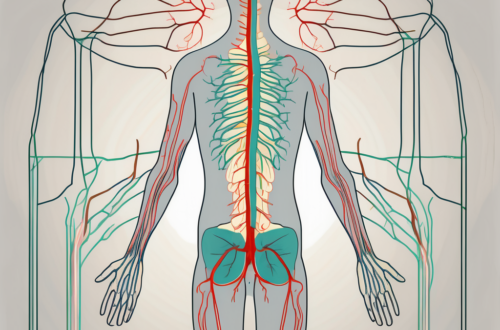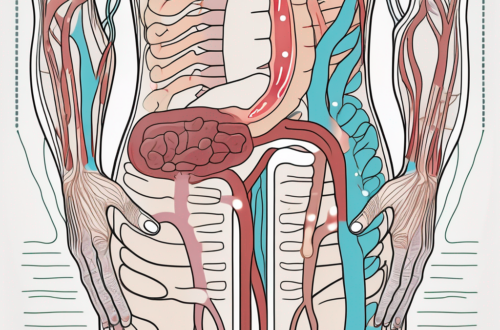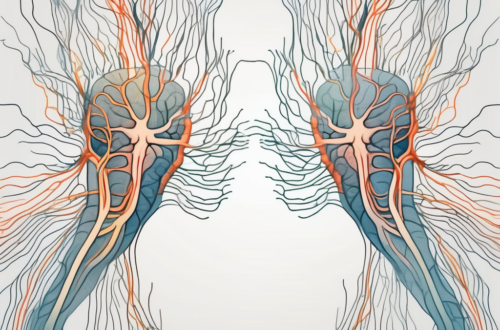The parasympathetic nervous system is a critical component of the autonomic nervous system, which controls many of the body’s involuntary functions. Understanding the role and function of the parasympathetic nervous system, as well as its anatomical structure and specific nerve branches, can provide valuable insights into how the body functions and responds to various stimuli. In this article, we will delve into the intricacies of the parasympathetic nervous system and explore its branches throughout the body.
Understanding the Parasympathetic Nervous System
Before diving into the specific nerve branches, it is essential to have a solid understanding of the parasympathetic nervous system as a whole. The parasympathetic nervous system works in opposition to the sympathetic nervous system, which is responsible for the body’s fight-or-flight response. While the sympathetic nervous system prepares the body for action and stress, the parasympathetic nervous system promotes rest, digestion, and other essential bodily functions that occur during periods of relaxation.
The parasympathetic nervous system is a complex network of nerves that plays a crucial role in maintaining the body’s overall balance and homeostasis. It acts as a counterbalance to the sympathetic nervous system, ensuring that the body can switch between states of heightened activity and rest.
One of the primary functions of the parasympathetic nervous system is to maintain homeostasis, ensuring that the body’s internal environment remains stable and balanced. It accomplishes this by conserving energy and promoting a state of rest and regeneration. Activation of the parasympathetic nervous system leads to a decrease in heart rate and blood pressure, while also stimulating digestion and facilitating the elimination of waste products.
The Role and Function of the Parasympathetic Nervous System
The parasympathetic nervous system plays a vital role in numerous bodily functions, including digestion, urination, sexual arousal, and even sleep. When the body is in a state of relaxation, the parasympathetic nervous system takes over, allowing for the proper functioning of these essential processes.
During digestion, the parasympathetic nervous system stimulates the release of digestive enzymes and increases blood flow to the digestive organs, promoting optimal nutrient absorption. It also helps regulate bowel movements, ensuring the smooth passage of waste through the intestines.
In terms of urination, the parasympathetic nervous system works to relax the muscles of the bladder, allowing for the controlled release of urine. This process is essential in maintaining proper urinary function and preventing issues such as urinary retention or incontinence.
Sexual arousal is another area where the parasympathetic nervous system plays a significant role. It is responsible for the release of nitric oxide, which causes blood vessels in the genital area to dilate, leading to increased blood flow and engorgement of erectile tissues in both males and females.
When it comes to sleep, the parasympathetic nervous system helps promote relaxation and a state of calmness, allowing the body to enter into restorative sleep cycles. It works in conjunction with other systems, such as the circadian rhythm, to regulate sleep-wake cycles and ensure adequate rest for optimal functioning.
The Anatomy of the Parasympathetic Nervous System
The parasympathetic nervous system consists of various nerve branches that originate from specific regions within the central nervous system. These nerve branches, primarily the cranial nerves and sacral nerves, innervate different organs and tissues, controlling their functions. Let’s explore each of these nerve branches in more detail.
The cranial nerves are a set of twelve pairs of nerves that emerge directly from the brain. Several of these cranial nerves, including the vagus nerve (cranial nerve X), play a significant role in the parasympathetic nervous system. The vagus nerve, in particular, is responsible for innervating organs in the thoracic and abdominal cavities, such as the heart, lungs, liver, and intestines.
On the other hand, the sacral nerves originate from the sacral region of the spinal cord. These nerves innervate the pelvic organs, including the bladder, reproductive organs, and parts of the large intestine. They are crucial for controlling functions such as urination, sexual arousal, and bowel movements.
Overall, the parasympathetic nervous system’s anatomy is a complex network of nerves that extends throughout the body, ensuring that vital organs and tissues receive the appropriate signals for proper functioning. Understanding the intricate connections and pathways of this system is essential for comprehending its role in maintaining overall health and well-being.
The Cranial Nerves in the Parasympathetic System
The cranial nerves play a vital role in the parasympathetic nervous system, providing direct innervation to several organs within the head and neck region. Understanding the functions of these nerves can shed light on how the parasympathetic system influences various physiological processes.
The parasympathetic system, often referred to as the “rest and digest” system, is responsible for promoting relaxation, conserving energy, and maintaining homeostasis. It counterbalances the sympathetic nervous system, which is responsible for the “fight or flight” response.
Let’s take a closer look at some of the cranial nerves involved in the parasympathetic system:
Oculomotor Nerve (III)
The oculomotor nerve controls the movement of the eye muscles responsible for pupil constriction and lens accommodation. Activation of this nerve helps regulate the amount of light entering the eye and ensures clear vision. In addition to its role in vision, the oculomotor nerve also innervates the muscles that control eyelid elevation and certain muscles involved in eye movement.
Damage to the oculomotor nerve can lead to various symptoms, including drooping eyelids (ptosis), double vision (diplopia), and difficulty focusing.
Facial Nerve (VII)
The facial nerve plays a crucial role in controlling the muscles of facial expression. Additionally, it innervates the lacrimal glands, responsible for tear production, as well as the sublingual and submandibular salivary glands, aiding in the production of saliva. This nerve also carries taste sensations from the anterior two-thirds of the tongue.
Facial nerve damage can result in facial weakness or paralysis, loss of taste, dry eyes, and dry mouth. It can also affect tear production, leading to dry eye syndrome.
Glossopharyngeal Nerve (IX)
The glossopharyngeal nerve provides innervation to the parotid salivary gland, which contributes to saliva secretion. This nerve also plays a role in taste perception and the regulation of blood pressure and heart rate. Additionally, it carries sensory information from the back of the tongue, tonsils, and the upper pharynx.
Injury or dysfunction of the glossopharyngeal nerve can result in difficulty swallowing (dysphagia), loss of taste sensation, and changes in blood pressure and heart rate regulation.
Vagus Nerve (X)
The vagus nerve is the longest and most widely distributed cranial nerve, innervating various organs throughout the body. It plays a vital role in regulating heart rate, gastrointestinal motility, and glandular secretion. The vagus nerve’s extensive connections make it a major player in the parasympathetic control of bodily functions.
In addition to its role in the parasympathetic system, the vagus nerve also carries sensory information from the throat, larynx, and abdominal organs to the brain. It helps regulate breathing, speech, and swallowing.
Damage to the vagus nerve can lead to a range of symptoms, including difficulty swallowing, hoarseness, changes in heart rate, gastrointestinal disturbances, and even fainting spells.
Understanding the intricate functions and connections of the cranial nerves in the parasympathetic system is essential for comprehending the complex interplay between the nervous system and various physiological processes. These nerves not only control specific organs but also contribute to overall well-being and homeostasis.
The Sacral Nerves in the Parasympathetic System
In addition to the cranial nerves, the sacral nerves also contribute to the parasympathetic nervous system. These nerves originate from the sacral region of the spinal cord and innervate organs within the pelvis and lower abdomen.
The sacral nerves, specifically the pelvic splanchnic nerves, play a crucial role in maintaining the proper functioning of various organs in the pelvic region. These nerves are responsible for regulating urinary and bowel functions, as well as controlling sexual arousal and orgasm.
Pelvic Splanchnic Nerves
The pelvic splanchnic nerves, derived from the sacral nerves, innervate organs such as the bladder, rectum, and reproductive organs. They play a crucial role in controlling urinary and bowel functions, as well as the initiation of sexual arousal and orgasm.
When it comes to urinary function, the pelvic splanchnic nerves are responsible for coordinating the relaxation of the bladder’s detrusor muscle and the contraction of the bladder’s internal sphincter. This coordination allows for the storage and controlled release of urine. Additionally, these nerves also play a role in the relaxation of the external urethral sphincter, allowing for the voluntary control of urination.
In terms of bowel function, the pelvic splanchnic nerves contribute to the regulation of the smooth muscle in the rectum. These nerves coordinate the relaxation of the rectal smooth muscle, allowing for the storage of feces, as well as the contraction of the rectal smooth muscle, facilitating defecation.
Furthermore, the pelvic splanchnic nerves are involved in the regulation of sexual function. They play a crucial role in the initiation of sexual arousal by facilitating the relaxation of the smooth muscle in the erectile tissues of the penis and clitoris. Additionally, these nerves also contribute to the coordination of the rhythmic contractions that occur during orgasm.
Overall, the sacral nerves, particularly the pelvic splanchnic nerves, are essential components of the parasympathetic nervous system. Their role in regulating urinary and bowel functions, as well as their involvement in sexual arousal and orgasm, highlights their significance in maintaining proper physiological functioning within the pelvis and lower abdomen.
The Parasympathetic Nervous System and the Body’s Response
The parasympathetic nervous system’s influence extends beyond its specific nerve branches and plays a significant role in the overall physiological response of the body.
The parasympathetic nervous system, often referred to as the “rest and digest” system, is responsible for promoting a state of relaxation and restoration in the body. It works in opposition to the sympathetic nervous system, which is responsible for the “fight or flight” response.
When the parasympathetic nervous system is activated, often during periods of rest and relaxation, it elicits the rest and digest response. This response promotes digestion, nutrient absorption, and energy storage. It also helps maintain a calm and balanced state, allowing the body to focus on regenerative processes.
One of the key ways in which the parasympathetic nervous system influences the body is through its effect on heart rate. Stimulation of the vagus nerve, one of the major parasympathetic nerves, leads to a decrease in heart rate. This physiological response is particularly important during periods of rest or when the body does not require increased cardiac output.
Furthermore, the parasympathetic nervous system’s influence on the digestive system is substantial. Activation of the parasympathetic nerves stimulates the release of digestive enzymes and increases blood flow to the gastrointestinal tract, enhancing nutrient absorption and promoting smooth muscle contractions for efficient digestion.
Not only does the parasympathetic nervous system play a role in heart rate regulation and digestion, but it also affects various other bodily functions. For example, it helps regulate bladder and bowel movements, promotes salivation, and stimulates tear production. Additionally, it plays a role in sexual arousal and reproductive functions.
In summary, the parasympathetic nervous system is an essential part of the body’s overall response. It promotes a state of relaxation, facilitates digestion and nutrient absorption, regulates heart rate, and influences various other bodily functions. Understanding the intricate workings of the parasympathetic nervous system is crucial for comprehending the body’s complex physiological responses.
Disorders Related to the Parasympathetic Nervous System
Although the parasympathetic nervous system is essential for maintaining overall health and well-being, certain disorders can arise that affect its proper functioning.
The parasympathetic nervous system plays a crucial role in regulating various bodily functions, including digestion, heart rate, and blood pressure. When this system is disrupted, it can lead to a range of disorders that impact an individual’s quality of life.
Dysautonomia
Dysautonomia refers to a group of disorders characterized by dysfunction of the autonomic nervous system. This dysfunction can manifest as an imbalance between the sympathetic and parasympathetic systems, leading to a wide range of symptoms such as rapid heart rate, digestive problems, and orthostatic hypotension.
Orthostatic hypotension is a condition where a person’s blood pressure drops significantly upon standing up, causing dizziness or fainting. This symptom is particularly common in individuals with dysautonomia, as the parasympathetic system fails to properly regulate blood pressure in response to changes in body position.
Furthermore, dysautonomia can also affect the digestive system, leading to issues such as constipation, diarrhea, and difficulty swallowing. These symptoms can significantly impact an individual’s daily life and require proper diagnosis and management from healthcare professionals.
Horner’s Syndrome
Horner’s syndrome occurs due to damage or disruption to the sympathetic nerves that innervate the face. While this syndrome primarily affects the sympathetic system, it can have implications for the parasympathetic system as well.
Individuals with Horner’s syndrome often experience a drooping of the eyelid, known as ptosis, on the affected side of the face. This occurs due to the disruption of sympathetic nerve signals that control the muscles responsible for lifting the eyelid. Additionally, a constricted pupil, known as miosis, may also be present on the same side as the ptosis.
Although the parasympathetic system is not directly involved in Horner’s syndrome, its interaction with the sympathetic system can influence various bodily functions. For example, the parasympathetic system regulates tear production, and disruption of sympathetic innervation can lead to decreased tearing on the affected side of the face.
Gastroparesis
Gastroparesis is a condition characterized by delayed emptying of the stomach. It can result from dysfunction in the muscles or nerves of the stomach, including the parasympathetic nerves that regulate gastric motility.
Individuals with gastroparesis may experience symptoms such as nausea, vomiting, early satiety, and bloating. These symptoms occur due to the impaired movement of food from the stomach to the small intestine, leading to a delay in digestion and absorption of nutrients.
The parasympathetic system plays a vital role in stimulating gastric motility, and any disruption to its function can contribute to the development of gastroparesis. Proper diagnosis and management of this condition are essential to alleviate symptoms and improve overall gastrointestinal health.
Treatment and Management of Parasympathetic Nervous System Disorders
When it comes to treating disorders related to the parasympathetic nervous system, a comprehensive approach is often required. Treatment options may vary depending on the specific disorder and its underlying cause.
Medication Options
In some cases, medications may be prescribed to manage symptoms and address the underlying dysfunction. These medications can help regulate heart rate, improve digestion, or target specific aspects of the parasympathetic nervous system. It is essential to consult with a healthcare professional to determine the most appropriate medication for each individual case.
Lifestyle Changes
Adopting healthy lifestyle habits can also play a significant role in managing parasympathetic nervous system disorders. This may include dietary modifications, regular exercise, stress management techniques, and adequate sleep. Lifestyle changes should be made in collaboration with a healthcare professional to ensure they are tailored to individual needs.
Surgical Interventions
In severe cases where conservative measures are insufficient, surgical interventions may be considered. These may involve repairing damaged nerves, removing obstructions, or implanting devices to regulate physiological functions. As with any surgical procedure, medical advice is crucial to determine the necessity and potential benefits of these interventions.
In conclusion, understanding the parasympathetic nerve branches and their role in the body is essential for comprehending the complex interplay between the nervous system and bodily functions. The parasympathetic nervous system plays a vital role in maintaining homeostasis, promoting rest and digestion, and regulating heart rate and digestion. However, disorders related to the parasympathetic system can disrupt these functions. Seeking medical advice and appropriate treatment options is crucial for managing these conditions effectively and maintaining overall well-being.





